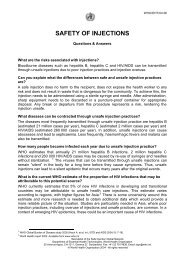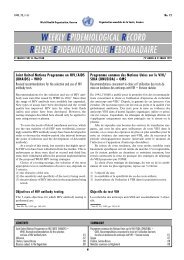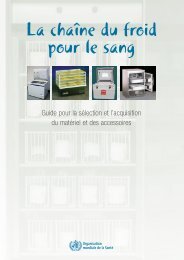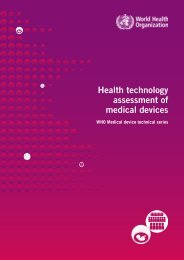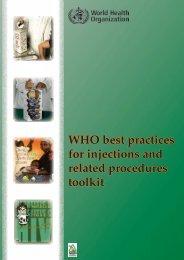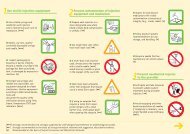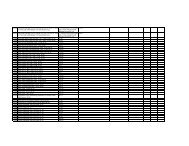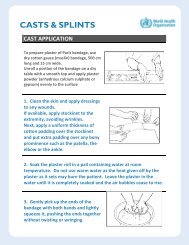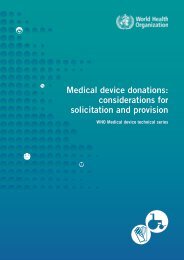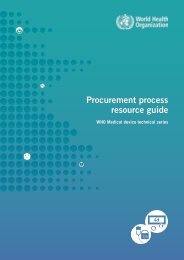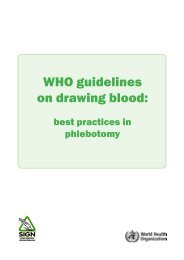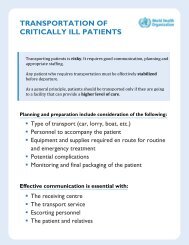SIGN meeting report 2003. - World Health Organization
SIGN meeting report 2003. - World Health Organization
SIGN meeting report 2003. - World Health Organization
You also want an ePaper? Increase the reach of your titles
YUMPU automatically turns print PDFs into web optimized ePapers that Google loves.
WHO strategy for waste management<br />
Richard Carr<br />
WHO, Geneva<br />
Understanding waste management, balancing risks<br />
<strong>Health</strong> care produces waste that may be dangerous to the health care worker, the waste<br />
handlers or the community at large, exposing them to infections, toxic chemicals or<br />
injuries. Also, the management of health care waste may be harmful, for example<br />
through the production of dangerous incineration emission that endangers the<br />
environment and leads to disease among humans. Thus, we need to understand and<br />
measure the risks associated with waste production and its management to make the<br />
most rational decisions. Failure to do so reduces the benefit that health care provides.<br />
The WHO strategy for waste management<br />
The WHO strategy for waste management has four objectives. First, generation of<br />
evidence and information for policy (disease burden, risks related to waste<br />
management, reference and guidance material). Second, preparation of decisionmaking<br />
material (guides, case studies and Internet products). Third, availability of safe<br />
waste treatment options (description and contacts, framework to develop low-cost<br />
options). Fourth, assistance to country plans (networks, national workshops, pilot<br />
projects and assistance to immunization waste management).<br />
Understanding the harm associated with incineration<br />
Standards for emission of dioxins, furans and PCBs in industrialized countries are low<br />
(0.1-5 ng TEQ * /m 3). .Small scale incinerators used in developing countries typically have<br />
higher emission rates (2-560 ng TEQ/m 3 ). However, standards in industrialized<br />
countries are developed based on the assumption that the incinerator will be running 8<br />
hours/day for 5 days/week. In practice, small scale incinerators at small hospitals run<br />
for 2 - 4 hours per week. The amount of toxic chemicals produced in four hours per<br />
week by a De Montfort incinerator would be less than that produced by small<br />
incinerators <strong>meeting</strong> the USA or Japan standards that ran for 40 hours/ week. United<br />
States and Japanese standards could be met but the European ones will be very difficult<br />
to meet in any case. Thus, adaptation is needed.<br />
Demonstration session on simple steps for infection control and prevention<br />
Ethics and waste management<br />
Dorothy Andere,<br />
JHPIEGO, Nairobi<br />
It is the moral responsibility of nurses and health care workers to protect patients from<br />
harm. They should not intentionally do anything harmful to themselves, their clients or<br />
the community. Nurses and administrators know that infection is spread by failure to<br />
provide a clean facility for use by sick and injured people. Cleaning the environment<br />
where you work in a health care setting is an issue for all cadres of health care workers<br />
whether it is done directly or delegated. Ultimately it is the nurse’s responsibility to<br />
protect patients and the public so that nosocomial infections do not occur.<br />
Waste management in practice<br />
Proper disposal of clinic wastes helps prevent the spread of infection not only to clinic<br />
personnel who handle the waste, but to the local community as well. It protects workers<br />
*<br />
Toxicity equivalent<br />
28



